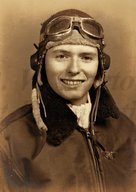
|

|
|
|
|
He was born in his family's home at 829 Kirby Place in Shreveport. (Note: Walter gives his mother's name as Mildred Covell Glassell, but fails to mention the name of his father, a World War I veteran and cotton broker. He refers to him affectionately as "Daddy.") Walter graduated from Byrd High School in 1942. As a freshman at Centenary College he was accepted into the Army Specialized Training Program (ASTP). He then passed entry tests for the Army Air Forces Aviation Cadets in January of 1943. Later that year, however, he was drafted into the U.S. Army and on June 28, 1943, was ordered to Camp Beauregard. After seven weeks his orders for flight training arrived, and he was sent to Amarillo Army Airfield in Amarillo, Texas. Walter was next dispatched to Central Washington College of Education in Ellensburg, Washington, where, he took four months of classes before entering flight training in Santa Ana, California. The entire class, however, was "washed out" in March of 1944. With long-range fighter escorts protecting bombers and crews, the Air Force did not need additional pilots. Walter calls that washing out "the biggest disappointment of my life." He was given the choice to remain in the Air Force as an enlisted man or to become a crewman on a bomber. He chose radio school to become a B-17 radio operator. He was sent to Sioux Falls, South Dakota for a twenty-six week-course in Morse code and other radio training. In November of 1944 he reported to Yuma Army Airfield in Arizona to gunnery school. There he fired fifty-caliber machine guns at stationery targets as well as at sleeves towed by B-25s. Walter also aimed at real airplanes but used frangible bullets made of graphite and plastic. Students fired at P-39s and P-63s outfitted with extra coatings of aluminum on the leading edges. Each time a frangible bullet hit, a light in the nose illuminated, like a pinball machine. After gunnery school Walter received corporal stripes and silver wings. B-17s were used mainly in Europe, while B-24s were the major bomber in the Pacific. With the war in Europe winding down, Walter switched to B-24s and attended a radio operator school. Tindell Field near Panama City, Florida. After training at Tindell Field near Panama City, Florida, he transitioned to a B-29 radio operator school in Lincoln, Nebraska. He was there when the war in the Pacific ended. On February 28, 1946 he was shipped to Camp Shelby near Hattiesburg, Mississippi where he was discharged as a sergeant. Back home, he graduated from Centenary with a degree in Business Administration in 1948. He then went to LSU and finished engineering school in two years. He loved college. "Suddenly here these men are all coming back and going to school," he says. "Our competition with the girls was these seventeen and eighteen-year-old kids just out of high school. It really wasn't much competition. Everybody who was ever in the service was a hero. My leather A-2 jacket with my wings on it was a real hit. A lot of the girls would have liked to have had that." After college he went to work first for the J.B. Beard Corporation in Shreveport as a supervisor of draftsmen, and then joined his father as a cotton broker. He married Gay Nell Little in 1954. Walter earned his real estate brokers' license and in 1968 began forty-seven years of working full-time as a realtor. Walter has two children and two grandchildren. He married Betty Lou Whitmeyer on August 16, 1981. |


